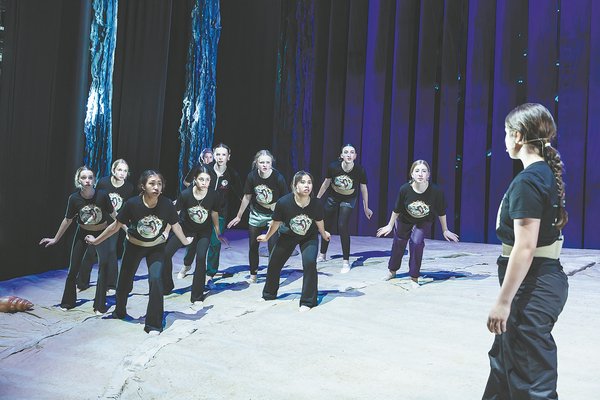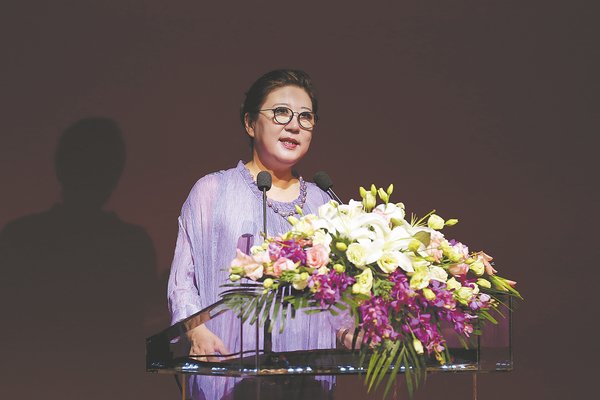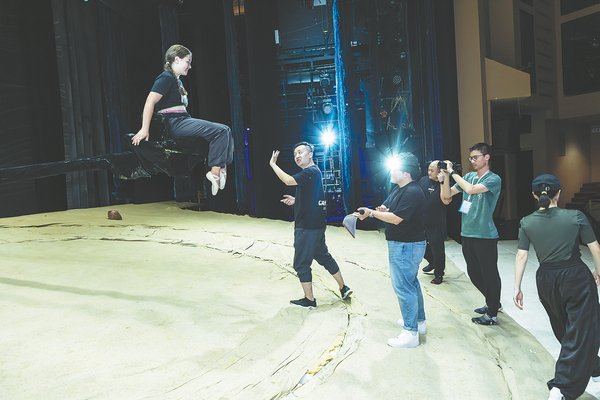August 11, 2023
BEIJING – Fifteen US teens perform beloved Chinese children’s play in Mandarin to astonished Beijing audiences.
Imagine that on your first trip to a foreign country as a teenager — be it Italy, Greece or Germany — and you are tasked with performing a play for a local audience in their language. Give this thought 5 to 10 seconds, and you may already be sweating bullets, or find that your heart is thumping in your throat.
While 15 girls aged between 12 and 17 from Montana and California in the United States managed to pull off this daunting task recently in Beijing, leaving their audience awestruck and moved, as they staged their first performance of Chinese Mermaid, a time-honored Chinese children’s play, on July 15 at the China National Theater for Children, kicking off the 12th China Children’s Theater Festival.
The show’s success is the result of more than a year of training and rehearsals, according to Chen Suhan, director and producer of the play.
In the summer of 2020, Chen and her team proposed to the China National Theater for Children the idea of inviting US students who are interested in the Chinese language and culture to perform Chinese Mermaid.
“I saw the play at least three times at the China National Theater for Children. The story, music and stage art really fascinated me,” Chen tells China Daily.

Scene from the recent performance of Chinese Mermaid featuring US teen performers Amare Swierc as Cai Ping, who is kidnapped by an evil dragon prince and turned into a mermaid, and Meilin Jokela as Jin Zhuzi, who spends his whole life trying to save Cai. CHINA DAILY
Based on folklore, Chinese Mermaid was co-written by famed playwright Huang Zongjiang and his daughter Ruan Dandi in the late 1970s. It follows the story of Jin Zhuzi, a kind, brave and tenacious boy who spends his life doing everything he can to deliver on his promise to rescue Cai Ping, a kindhearted girl who has been kidnapped and turned into a mermaid by an evil Dragon Prince, and restore her legs.
The play created a sensation following its debut in 1981, prompting comic books to be made from stage photos of the performance. In 2015, the theater revived the play with modern stage design and has since put on over 70 performances.
“Chinese Mermaid is a classic of our repertoire. It has won the approval of generations of theatergoers,” says Feng Li, president of the China National Theater for Children.
“It embodies traditional Chinese aesthetics and values such as being kind and honoring one’s commitments. As these are universal values that resonate easily with children from other cultures, we accepted Chen’s proposal,” she adds.

Scene from the recent performance of Chinese Mermaid featuring US teen performers Amare Swierc as Cai Ping, who is kidnapped by an evil dragon prince and turned into a mermaid, and Meilin Jokela as Jin Zhuzi, who spends his whole life trying to save Cai. CHINA DAILY
Long-standing ties
Chen’s choice of working with the Rocky Mountain Ballet Theater in Montana, the US host of this project, led to the decision to incorporate ballet into the US version.
Founded in 1998 by Charlene Carey, the RMBT offers young people training in ballet and performance, and organizes cultural exchanges. The company has long-standing ties with China and, in 2008, it visited for the first time, bringing a group of 48 dancers and students on a two-week tour to China. It has since visited many times, participating in art festivals in a number of cities, including Xi’an, Shaanxi province, Shanghai and Chongqing.
“This was a great collaborative project, specifically designed for our group of young American artists and academics. We were very pleased with the results,” says Carey, artistic director of the play.
Chen and the company began auditioning actors in California and Montana three years ago.
“Our first audition in Los Angeles attracted nearly 200 students. Then we held two more auditions in San Francisco and Montana,” Chen says.
Around 30 students were cast, most of them interested in dance and theater, but only 15 made the cut after eight rounds of training and selection, according to Chen.
As most of the actors did not speak Chinese, learning to understand their lines and roles was the first challenge. That was the case for Amare Swierc, the show’s lead. The 17-year-old says she practiced the script for over a year.
“I started with the pronunciations after reading the translated version. Then I practiced pronouncing the lines.
“Over time, I was able to add meaning to the words and eventually, I knew what I was saying,” Swierc says.
“It was really just repetition and listening to the recordings of people saying the lines, over and over.”
Charlotte McCarty who, at age 12, is the youngest member of the cast, found a tutor to help her practice her lines. In 2021, the girl started taking an online course in Chinese language and culture.
Authorized by the China National Theater for Children, Chen and her team condensed the script and made the lines shorter and simpler, and Walter Barrera, a dancer and choreographer at the RMBT, choreographed the play.
COVID-19 was the biggest obstacle preventing cast members, who are from the four cities of Missoula, Los Angeles, Berkeley and Sacramento, from rehearsing together.
Even though most of the training and language learning had to be done online, the cast still managed to hold three in-person rehearsals.
“In 2022, running the risk of contracting COVID, the girls flew to Los Angeles to rehearse together with masks on. Their perseverance and effort greatly moved me,” Feng says.
Shortly after their last full-cast rehearsal in Missoula in June, the 15 girls and their teachers arrived in Beijing on July 5.

The cast rehearsing at the China National Theater for Children, in Beijing in July.
Life-changing experience
At the China National Theater for Children, cast members put on tailor-made costumes and began nine days of rehearsals under the direction of Liao Wei, a veteran actor and executive director of the 2015 production.
“I was impressed that they arrived so prepared regarding lines and movements,” Liao recalls.
“I had some qualms about working with a group of teenage American girls, but despite some difficulty communicating at first, we gradually developed a rapport,” he says.
Training every day from 8:30 am to 5:30 pm, both Liao and Chen say the cast worked well and hard, giving the play their full attention.
Liao says the difficulty of working with the US cast lay in making their interpretation of a Chinese play more convincing to a Beijing audience.
“Chinese Mermaid is usually performed by adult Chinese professionals who are more reserved by nature. But the girls have been trained in ballet and their performance radiated the freedom and spontaneity typical of American teens,” says Liao.
The director tried to retain the free, spontaneous spirit of the performances, while focusing on helping the actors master their lines and the key movements in each act.
What impressed Liao the most were the thank-you letters he and his colleagues received toward the end of the rehearsals.
“Getting those letters, handwritten in English, pinyin and even Chinese, some even illustrated with sketches, meant the world to me and made all the work I did worthwhile,” Liao says.
“The letters showed their appreciation not only of my work, but also of the China National Theater for Children and Chinese culture.”
On July 15 and 16, the play was performed twice to a packed theater.
“Their performance was incredible! They spoke Chinese so well. It’s no easy task that they memorized all the lines. The play is more than an hour long,” commented one Beijing middle school student after the show.
Nearly 500 primary and middle school and university students attended the matinee on July 16 and met the cast to talk and exchange ideas on a number of topics, including learning foreign languages, acting and career plans.
Meilin Jokela, who plays Jin Zhuzi, says practicing her lines and rehearsing in the US always felt a bit unreal.

Feng Li
“Coming to Beijing to finally perform on such a beautiful stage was like a dream come true,” she says.
Swierc says, “Everybody we’ve worked with, especially on the Chinese Mermaid team, is so accommodating and welcoming.
“Regardless of any prejudice you have against this country, or any prior stereotypes embedded in your mind, it’s just an amazing culture and I’m so lucky to explore it.”
She adds, “This experience has really changed my life. Not only exploring a culture so different from my own, but also being able to embody the character of Cai Ping.”
Swierc will start at Duke University this fall. She says she is interested in coming back to China as part of Duke’s exchange program at its campus in Kunshan, Jiangsu province.
“I feel I will carry Cai Ping and the experience of playing her with me into a professional role in the future that embodies the foreign language, cultural immersion style,” Swierc says.
Many other cast members also say the experience is etched into their memories, and that they plan to continue to learn Chinese.
Feng says the experience could create lifelong ties between the US teens and China.
“For some of them, this experience may become a factor influencing future career choices, and their perception of China and Chinese culture may also have changed because of it,” she says.

Swierc receives instructions from Liao Wei, a veteran actor and executive director at the China National Theater for Children. CHINA DAILY
A universal language
“What we have done is a bit like building a bridge. It may not be large or wide, but it has connected our hearts and made unforgettable memories,” Liao says.
Even though the US version of Chinese Mermaid is the first classic the China National Theater for Children has authorized a non-Chinese organization to stage in its 68 years of existence, the theater has promoted youth cultural exchanges between China and the US for many years.
In 2015 for example, it invited the Missoula Children’s Theater to participate in the 5th China Children’s Theater Festival, during which Chinese and US students performed The Princess and the Pea, a classic children’s play, in English. The following year, eight US students performed excerpts from Idiom Cube, a play based on Chinese idioms, in Chinese.
“I see theater as a universal language for children around the world. Since 2014, we have been invited to perform in 36 countries and regions, and our plays, most of which are rooted in traditional Chinese culture, have won the hearts of audiences,” Feng says.
The president says the theater will continue to stage children’s dramas promoting traditional Chinese values, and take them to audiences around the world, igniting the interest of youngsters in China and Chinese culture.
“The successful collaboration with the RMBT has also inspired us to collaborate more with overseas organizations specializing in theater or art education.”


